To the unseasoned gardener, Lichen can often be mistaken for mold. It isn’t hard to see why either.
It does have that appearance, but this scratchy, greenish, abstract growth is created by the natural combining of fungus and alga.
Lichen is found in many places which include tree bark, wood, rocks, glass, plastic, and even metal. You may have wandered past millions of them in the wild without noticing. They kind of just blend into nature. When it comes to learning how to grow lichen indoors, it is very easy to master.
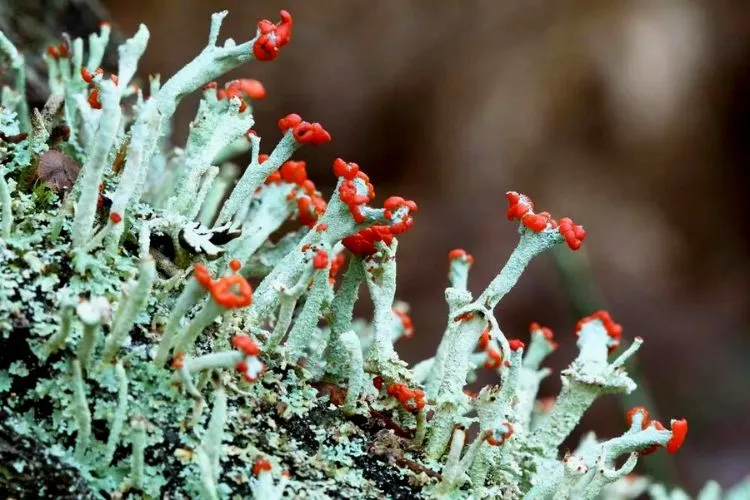
Like most plants, all that is needed is replicating their growing environment. Ensuring the humidity is around 50% and allowing at least 7 hours of indirect sunlight exposure per day is optimal.
Our detailed research and guidance on this topic are aimed at helping anyone concerned about growing lichen indoors.
Table of Contents
Is Lichen a plant or fungus?
Lichen is neither fungi nor a plant. It is a combination of fungi and alga. These 2 organisms work together to create a symbiotic partnership. The dominant partner is the fungus.
This organism gives the lichen many visual and mechanical characteristics, from its shape to the way it blooms or fruits.
The algal part of the lichen is like the engine.
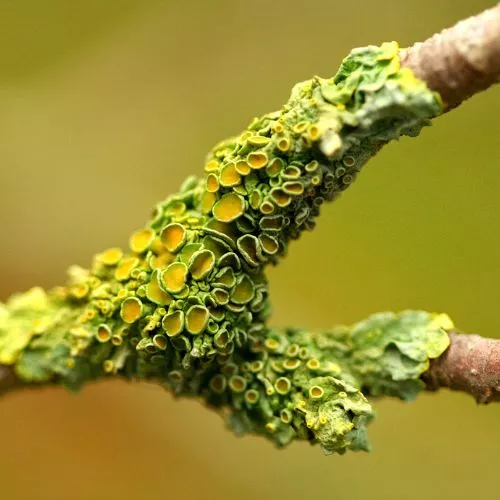
It is in charge of photosynthesis and provides food, enabling it to grow and spread effectively. Lichen is an extremely impressive feat of nature that is often unappreciated.
What are the Perfect Growing Conditions for Lichen?
Lichen is quite an adaptable ‘organism’. They exist even in areas where vital nutrients and water may be scarce. However, to grow it effectively and in abundance, it does require some specific conditions.
That’s why before knowing how to grow lichen indoors, we must understand the perfect conditions as well.
Understanding these requirements is important of allowing growth to be controlled and measured within the environment. These include:
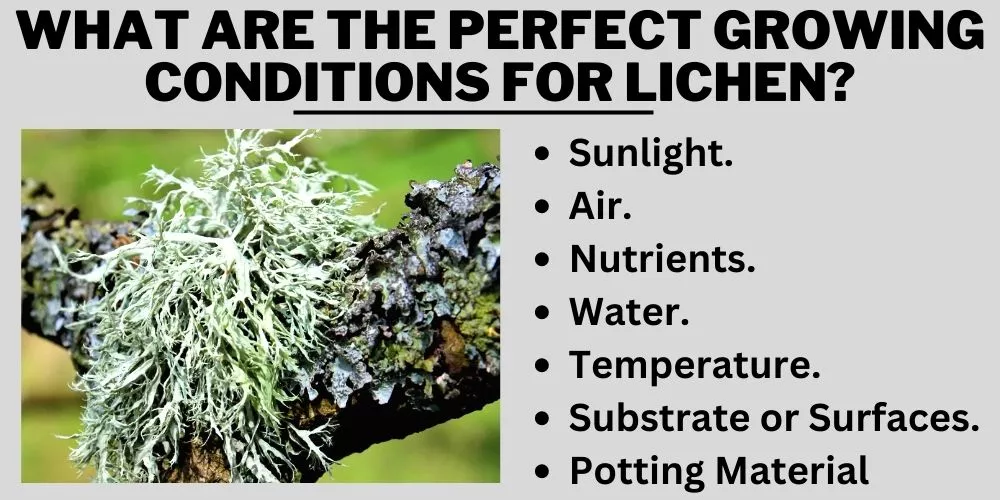
Sunlight
Sunlight is extremely important for lichen. It enables the algal part to photosynthesise effectively. Sunlight is its primary food source. The bigger and faster it grows, the further it can spread out to soak in more sunlight. Different species of lichen have different sunlight requirements.
It all depends on their makeup (morphology). Some species may even suffer from sun stress sooner than others. When considering the sunlight hours required for such an organism, we must look at their natural growing environments.
With that said, it’s safe to say that, in general, most species require 6-7 hours of indirect sunlight per day.
Air
Much like us humans, lichens need fresh, clean air. We can learn a lot about the quality of the surrounding air by observing a lichen. The lichen will start to dry out and die when pollution is present in the air. This is why we see lichen in urban areas.
They absorb everything into their cortex, from beneficial nutrients to harmful toxins. Additionally, lichens use environmental air as a source of food.
They can obtain nitrogen, carbon and oxygen by soaking them in from their surroundings. It’s worth noting these characteristics when deciding where to grow them in the home.
Nutrients
Unlike traditional plants, lichen doesn’t have roots that soak in water and nutrients from underground. Instead, their nutrients are obtained by soaking in the surrounding atmosphere.
This can come from any possible decaying organic remains found on the substrate, misted moisture or rain, dust, and any other fallout that may be floating in the air.
Their main nutrients include nitrogen, carbon and oxygen. Lichen uses a process called cyanobacteria which enables it to “fix” nitrogen soaked in from the atmosphere, making it usable. Carbon and oxygen also come from the surrounding air.
Water
The water requirements for a lichen can vary. Generally, though, misting them once a week is ample and will ensure that it thrives comfortably. Again, we need to have a look at their natural environment. Some days they receive water in abundance, and some days are scarce. Keeping it lightly moist is a perfect way to treat lichen.
Temperature
Most species of lichen grow best in colder climates. They flourish when the temperature is below 50°F (10°C). In contrast, warmer temperatures will make them go dormant.
When temperatures soar, they can burn and die. Anything over 70°F (21°C) will start to dry it out. The moisture content in a growing environment will greatly increase its chances of survival there.
Substrate or Surfaces
Lichen thrives best on surfaces that aren’t disturbed. Furthermore, they prefer being substrates where they can be exposed to adequate sunlight, rainwater, and airborne materials.
The ideal places include tree trunks, branches, twigs, bark, most moss types, rock, some soils, plastic, metal, plastic and, in some cases, even glass.
Potting Material
It’s not so common to grow lichen on traditional potting materials. They prefer to be able to latch onto a harder, more coarse substrate and establish their growth ‘feelers’.
They can easily grow in glass containers such as terrariums. Adding a few rocks or pieces of wood into the container can improve the conditions and aesthetics.
How to grow lichen indoors? Step By Step Procedure
Learning how to grow lichen indoors is a pretty simple task. The only thing you’ll need a lot of is time. They grow extremely slowly; some species grow 1mm per year. Others can grow around 0.5 mm per year to 500 mm per year.
Let’s look at how to grow some of these intriguing fungi/alga organisms in step-by-step form. Our favorite is reindeer lichen (a.k.a deer moss), so we’ll go through the process using this type. They can grow up to 1-4 inches and are usually white and fluffy.
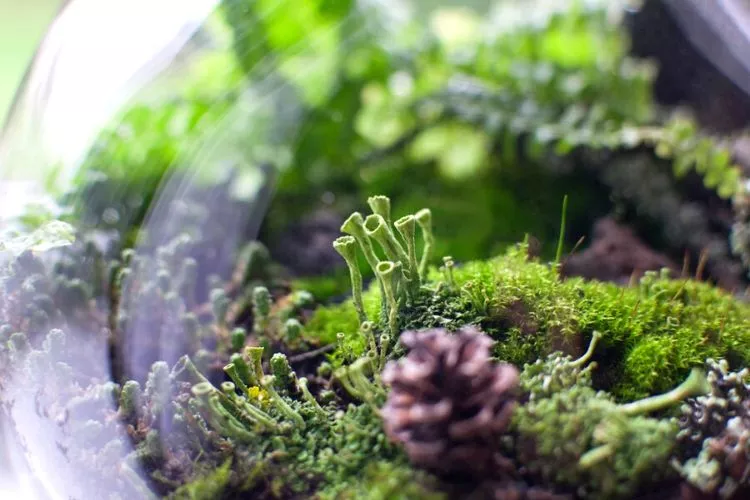
What you will need:
- Clear glass or plastic Container (fish bowl, glass jar, mason jar, bottle)
- Plastic wrap or lid
- Gravel
- Growing Medium (1:1:2) 1 part loam, 1 part sand, 2 part hummus works best
- Twigs and small rocks
- Reindeer lichen (Deer moss)
- Chopsticks
- Spray Bottle and clean distilled water (if possible)
- Soft cloth or tissue:
Step By Step Methods To Grow Lichen Indoors:
- Collect the Lichen, the more, the better.
- Add around 1-2 inches of gravel to the bottom of the growing container and level it out.
- Add a 2-4 inch layer of your growing medium on top of the gravel.
- Next, carefully place twigs and small rocks in whatever arrangement you like. This will be the finished look, so play around with style a bit.
- Then add the reindeer lichen to the twigs and rocks.
- Once you have a good position, take the chopsticks and manipulate the lichen into place to stabilize it. This part can be a bit tedious but well worth the extra effort.
- Give the lichen a light spray with water and a spray bottle.
- Use the cloth or tissue to remove any excess moisture or condensation that may have built up when spraying.
- Seal the container with its lid or a tight fitting plastic wrap.
- Place the lichen and its container in a well light area with temperatures that won’t exceed 70°F (21°C)
- Observe the lichen as it grows and aims to keep it moist by misting it every 3-7 days. Avoid letting the lichen dry out.
Can lichen grow in a terrarium?
A terrarium is a great place for lichen to grow. They are transparent, which allows adequate light and allows you to observe them.
Simply fill the bottom few inches with gravel, and layer it again with a well-blended 1 part loam, 1 part sand, and 2 part hummus growing medium. Add rocks and twigs, followed by your arranged lichen. Mist regularly and enjoy!
Here are some tips when building your terrarium
Building your terrarium produces the best results when the creative juices are flowing. There is no general rule; as long as there is some gravel and growing medium on the base, the rest is up to the feel you are trying to create. Once your setup is up, there are a few simple tips you should follow
- If condensation builds up whilst misting, open the lid slightly to allow airflow to evaporate.
- Turn the terrarium one way regularly to ensure the lichen spreads in all directions. E.g., Try turning 5cm clockwise per week.
- Tinted, cloudy or colored glass affects plant growth by blocking available light. Try to use clean, clear glass if possible.
How do you care for indoor lichens?
Lichens are pretty low maintenance, especially considering that they grow extremely slowly. Caring for them when growing indoors is pretty simple. These types of organism growths need regular misting, and the humidity should be kept around 50% if possible. Try to have them soak in at least 7 hours of indirect sunlight per day.
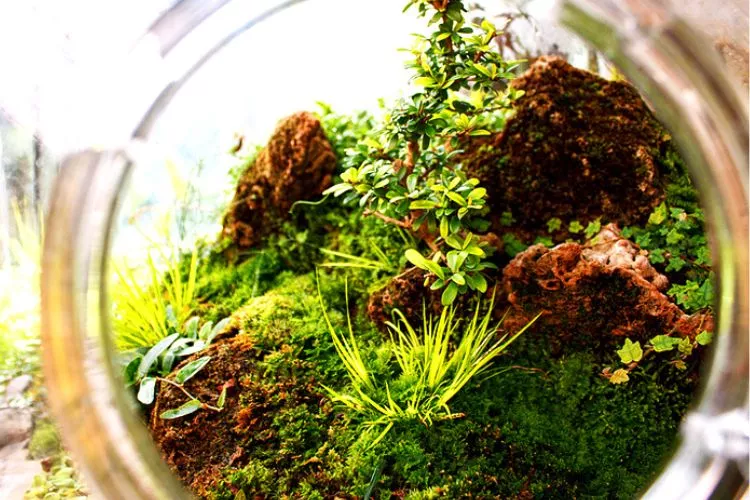
Even better, give their growing container a bit of a spin every week to allow the whole lichen to enjoy the sunlight. Otherwise, it will only grow on the side the sun sees, making it look lopsided.
Avoid exposing them to temperatures above 70°F (21°C) as they will dry out and die. When in doubt, think about how they grow in their natural environment and place their container similarly to the atmosphere.
Frequently Asked Questions (FAQs)
How do you grow lichens at home?
It is possible to grow lichen from flake at home by first boiling together 500ml full-cream cow’s milk, 1 tsp wheat flour, 1 tsp dry yeast, ½ tsp powdered gelatine, 1 tbsp green algae (e.g. spirulina, kelp, chlorella etc.) powder and a few drops liquid fertilizer. Let it cool, and add 2 tsp lichen flakes and 2 tsp healthy soil. Then paste this mix on the rocks or branches in your terrarium that you want it to grow on.
How to grow lichen on pots?
Fill the pot with 1-2 inches of gravel, then 3-4 inches (1 part loam, 1 part sand, 2 part hummus) of potting mix. Add some rocks and branches and gently arrange the desired lichen. Mist and keep moist. Lichen grows slowly, sometimes as little as 0.5-500 mm per year.
How to transplant lichen?
Transplanting lichen is quite simple. Gently scrape underneath the lichen you wish to transplant. You may need a sharp knife first, then something a little more smooth to slide underneath. Try to keep it whole and undamaged. Then add it to your prepared terrarium or another new home for it.
Conclusion:
Lichen is often passed by and goes unnoticed. Who would have thought that it would have such a complex nature?
Additionally, growing it indoors is easy if you understand a few basic principles. We hope this article has been helpful, and we look forward to producing more to help you on your gardening journey. As always, happy growing.


